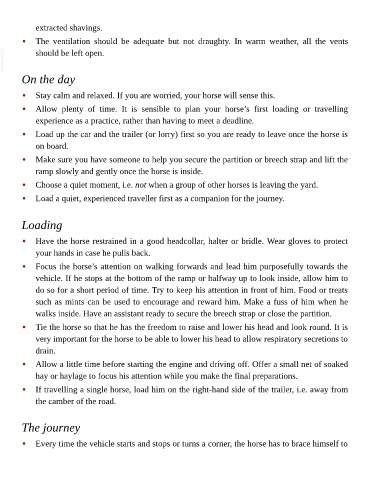Page 1144 - The Veterinary Care of the Horse
P. 1144
extracted shavings.
• The ventilation should be adequate but not draughty. In warm weather, all the vents
VetBooks.ir should be left open.
On the day
• Stay calm and relaxed. If you are worried, your horse will sense this.
• Allow plenty of time. It is sensible to plan your horse’s first loading or travelling
experience as a practice, rather than having to meet a deadline.
• Load up the car and the trailer (or lorry) first so you are ready to leave once the horse is
on board.
• Make sure you have someone to help you secure the partition or breech strap and lift the
ramp slowly and gently once the horse is inside.
• Choose a quiet moment, i.e. not when a group of other horses is leaving the yard.
• Load a quiet, experienced traveller first as a companion for the journey.
Loading
• Have the horse restrained in a good headcollar, halter or bridle. Wear gloves to protect
your hands in case he pulls back.
• Focus the horse’s attention on walking forwards and lead him purposefully towards the
vehicle. If he stops at the bottom of the ramp or halfway up to look inside, allow him to
do so for a short period of time. Try to keep his attention in front of him. Food or treats
such as mints can be used to encourage and reward him. Make a fuss of him when he
walks inside. Have an assistant ready to secure the breech strap or close the partition.
• Tie the horse so that he has the freedom to raise and lower his head and look round. It is
very important for the horse to be able to lower his head to allow respiratory secretions to
drain.
• Allow a little time before starting the engine and driving off. Offer a small net of soaked
hay or haylage to focus his attention while you make the final preparations.
• If travelling a single horse, load him on the right-hand side of the trailer, i.e. away from
the camber of the road.
The journey
• Every time the vehicle starts and stops or turns a corner, the horse has to brace himself to

